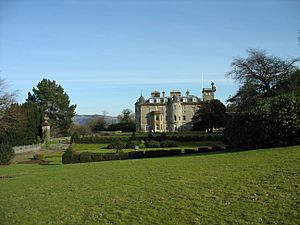Finlaystone House facts for kids
Quick facts for kids Finlaystone House |
|
|---|---|

Finlaystone House, west front
|
|
|
Listed Building – Category A
|
|
| Designated | 10 June 1971 |
| Reference no. | LB13641 |
|
Inventory of Gardens and Designed Landscapes in Scotland
|
|
| Designated | 1 July 1987 |
| Reference no. | GDL00180 |
| Lua error in Module:Location_map at line 420: attempt to index field 'wikibase' (a nil value). | |
Finlaystone House is a large country house and estate in Inverclyde, Scotland. It sits close to the Firth of Clyde, near the village of Langbank. This historic property is located in the west central Lowlands of Scotland.
Finlaystone was first owned by the Dennistoun family. In the 15th century, it became the property of the Cunningham family. It was the main home for the Earl of Glencairn until 1796. Today, it belongs to the Chief of Clan MacMillan. The house is a very important historic building, known as a category A listed building. Its beautiful gardens are also officially recognized in the Inventory of Gardens and Designed Landscapes in Scotland. This means they are considered significant gardens in the country.
Contents
A Look Back: Finlaystone's History
Early Owners and Royal Connections
In the late 1300s, King Robert II officially gave the lands of Finlaystone to Sir John de Danyelstoun. His son, Sir Robert, later became the keeper of Dumbarton Castle. When Sir Robert passed away in 1399, his lands were split between his two daughters. Margaret received Finlaystone.
In 1405, Margaret married Sir William Cunningham. His family then owned Finlaystone for many centuries. It became the main home for the Cunningham family, who were the leaders of Clan Cunningham.
The Earls of Glencairn
William's grandson, Alexander, was given the title of Earl of Glencairn in 1488. The Cunningham family were strong supporters of the Scottish Reformation. This was a time when Scotland changed its main religion from Catholicism to Protestantism. In 1556, they even hosted the world's first Protestant Reformed communion service at Finlaystone. This service was led by the famous preacher John Knox.
Building the Modern House
In 1746, plans were made for a new house by architect John Douglas. However, construction didn't start until 1764. The new Finlaystone House was built to include parts of the older 15th-century castle. In 1796, the 15th Earl of Glencairn, John Cunningham, died without children. Finlaystone then went to a cousin, Robert Graham of Gartmore. His family later changed their name to Cunninghame Graham.
New Owners and Renovations
The Cunninghame Grahams sold Finlaystone in 1862 to Sir David Carrick-Buchanan. He then sold it in 1882 to George Jardine Kidston. Kidston hired the architect John James Burnet to redesign the house. Burnet gave it a new look in the Scots Baronial style, which was finished in 1903. This style often includes towers and fancy stonework, making it look like an old Scottish castle.
During the early 1900s, the gardens and grounds around the house were made much larger and new plants were added. George Kidston's granddaughter, Marian, married General Sir Gordon MacMillan. He was the Chieftain of the Clan MacMillan.
Finlaystone Today
Their son, George Gordon MacMillan, is the current chief of Clan MacMillan and the owner of Finlaystone. Today, the estate is a popular place for visitors. It offers lovely walks and fun play areas within its 10-acre gardens.

